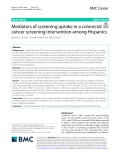
Prevention and early detection of cancer
-
Colorectal cancer (CRC) is the second leading cause of cancer deaths in the USA. Although a number of CRC screening tests have been established as being effective for CRC prevention and early detection, rates of CRC screening test completion in the US population remain suboptimal, especially among the uninsured, recent immigrants and Hispanics.
 13p
13p  vielonmusk
vielonmusk
 21-01-2022
21-01-2022
 10
10
 1
1
 Download
Download
-
Lung Cancer Chest x-ray and sputum cytology have been evaluated in randomized lung cancer screening trials. No reduction in lung cancer mortality has been seen, although all the controlled trials have had low statistical power. Even screening of high-risk subjects (smokers) has not proven beneficial. Spiral CT can diagnose lung cancers at early stages; however, false-positive rates are high. Spiral CT screening increases the number of lesions detected and increases the number of diagnostic and therapeutic procedures. However, its capacity to save lives is unproven.
 8p
8p  konheokonmummim
konheokonmummim
 03-12-2010
03-12-2010
 123
123
 2
2
 Download
Download
-
Breast Cancer Breast self-examination, clinical breast examination by a care giver, and mammography have been advocated as useful screening tools. Only screening mammography alone and screening mammography with clinical examination have been evaluated in randomized controlled trials. MRI is being assessed and is more accurate than mammography in women at high risk due to genetic predisposition or in women with very dense breast tissue.
 5p
5p  konheokonmummim
konheokonmummim
 03-12-2010
03-12-2010
 91
91
 5
5
 Download
Download
-
Screening for Specific Cancers Widespread screening for cervical, colon, and likely breast cancer is beneficial for certain age groups. A number of organizations have considered whether or not to endorse routine use of certain screening tests. Because these groups have not used the same criteria to judge whether a screening test should be endorsed, they have arrived at different recommendations. The U.S. Preventive Services Task Force (USPSTF), the Canadian Task Force on Preventive Health Care, and the American Cancer Society (ACS) publish screening guidelines (Table 78-3).
 5p
5p  konheokonmummim
konheokonmummim
 03-12-2010
03-12-2010
 85
85
 3
3
 Download
Download
-
Cancer Screening Screening is a means of detecting disease early in asymptomatic individuals, with the goal of decreasing morbidity and mortality. While screening can potentially save lives and has been shown to do so in cervical, colon, and probably breast cancer, it is also subject to a number of biases that can suggest a benefit when actually there is none. Biases can even mask net harm. Early detection does not in itself confer benefit. To be of value, screening must detect disease earlier, and treatment of earlier disease must yield a better outcome than treatment at the onset of...
 5p
5p  konheokonmummim
konheokonmummim
 03-12-2010
03-12-2010
 70
70
 3
3
 Download
Download
-
Potential Biases of Screening Tests The common biases of screening are lead time, length-biased sampling, and selection. These biases can make a screening test seem beneficial when actually it is not (or even causes net harm). Whether beneficial or not, screening can create the false impression of an epidemic by increasing the number of cancers diagnosed. It can also produce a shift in proportion of patients diagnosed at an early stage that improves survival statistics without reducing mortality (i.e.
 5p
5p  konheokonmummim
konheokonmummim
 03-12-2010
03-12-2010
 74
74
 3
3
 Download
Download
-
Chemoprevention of Breast Cancer Hormonal manipulation is being tested in the primary prevention of breast cancer. Tamoxifen is an antiestrogen with partial estrogen agonistic activity in some tissues, such as endometrium and bone. One of its actions is to upregulate transforming growth factor β, which decreases breast cell proliferation. In randomized placebo-controlled trials to assess tamoxifen as adjuvant therapy for breast cancer, tamoxifen reduced the number of new breast cancers in the opposite breast by more than a third.
 5p
5p  konheokonmummim
konheokonmummim
 03-12-2010
03-12-2010
 72
72
 3
3
 Download
Download
-
Chemoprevention of Cancers of the Upper Aerodigestive Tract Smoking causes diffuse epithelial injury in the head, neck, esophagus, and lung. Patients cured of squamous cell cancers of the lung, esophagus, head, and neck are at risk (as high as 5% per year) of developing second cancers of the upper aerodigestive tract. Cessation of cigarette smoking does not markedly decrease the cured cancer patient's risk of second malignancy, even though it does lower the cancer risk in those who have never developed a malignancy.
 5p
5p  konheokonmummim
konheokonmummim
 03-12-2010
03-12-2010
 61
61
 2
2
 Download
Download
-
Physical Activity Physical activity is associated with a decreased risk of colon and breast cancer. A variety of mechanisms have been proposed. However, such studies are prone to confounding factors such as recall bias, association of exercise with other health-related practices, and effects of preclinical cancers on exercise habits (reverse causality). Recommending adults to engage in at least 30 min of vigorous activity for ≥3 days a week is good health advice, though its effects on cancer incidence are unproven.
 5p
5p  konheokonmummim
konheokonmummim
 03-12-2010
03-12-2010
 85
85
 4
4
 Download
Download
-
Cancer Chemoprevention Chemoprevention involves the use of specific natural or synthetic chemical agents to reverse, suppress, or prevent carcinogenesis before the development of invasive malignancy. Cancer develops through an accumulation of genetic and epigenetic changes that are potential points of intervention to prevent cancer. The initial changes are termed initiation. The alteration can be inherited or acquired through the action of physical, infectious, or chemical carcinogens.
 6p
6p  konheokonmummim
konheokonmummim
 03-12-2010
03-12-2010
 82
82
 3
3
 Download
Download
-
Harrison's Internal Medicine Chapter 78. Prevention and Early Detection of Cancer Prevention and Early Detection of Cancer: Introduction Improved understanding of carcinogenesis has allowed cancer prevention and early detection (also known as cancer control) to expand beyond the identification and avoidance of carcinogens. Specific interventions to prevent cancer in those at risk, and more sensitive and specific screening for early detection of cancer are the goals.
 5p
5p  konheokonmummim
konheokonmummim
 03-12-2010
03-12-2010
 114
114
 4
4
 Download
Download
CHỦ ĐỀ BẠN MUỐN TÌM























